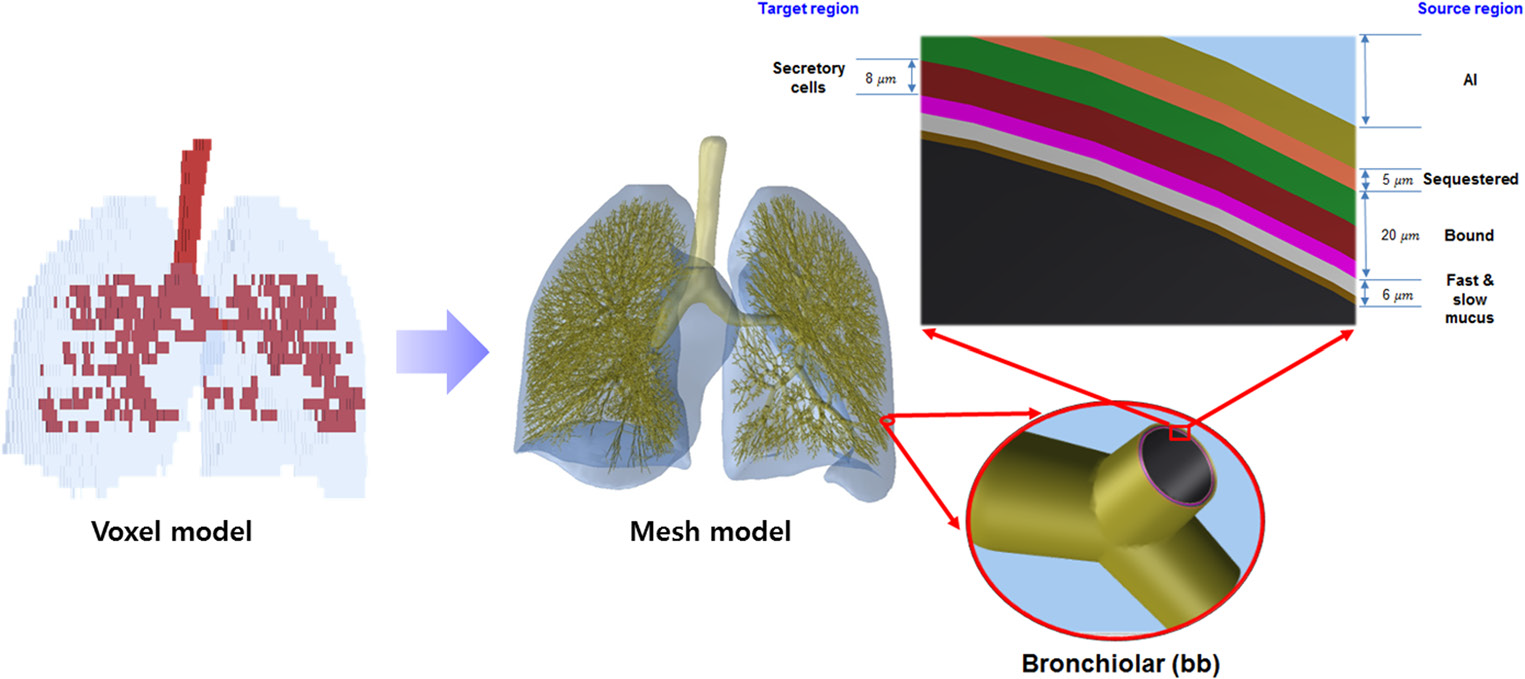글로벌 연구동향
의학물리학
![[Phys Med Biol] Inclusion of thin target and source regions in alimentary and respiratory tract systems of mesh-type ICRP adult reference phantoms.](/enewspaper/upimages/admin_20170413113932_R.jpg) 2017년 04월호
2017년 04월호
[Phys Med Biol] Inclusion of thin target and source regions in alimentary and respiratory tract systems of mesh-type ICRP adult reference phantoms.한양대/ 김한성, 김찬형*
- 출처
- Phys Med Biol
- 등재일
- 2017 Mar 21
- 저널이슈번호
- 62(6):2132-2152. doi: 10.1088/1361-6560/aa5b72. Epub 2017 Jan 23.
- 내용

Lung model of voxel-type ICRP male reference phantom (left) and mesh-type ICRP reference male phantom along with micrometer-thick target and source regions (right).
Abstract
It is not feasible to define very small or complex organs and tissues in the current voxel-type adult reference computational phantoms of the International Commission on Radiological Protection (ICRP), which limit dose coefficients for weakly penetrating radiations. To address the problem, the ICRP is converting the voxel-type reference phantoms into mesh-type phantoms. In the present study, as a part of the conversion project, the micrometer-thick target and source regions in the alimentary and respiratory tract systems as described in ICRP Publications 100 and 66 were included in the mesh-type ICRP reference adult male and female phantoms. In addition, realistic lung airway models were simulated to represent the bronchial (BB) and bronchiolar (bb) regions. The electron specific absorbed fraction (SAF) values for the alimentary and respiratory tract systems were then calculated and compared with the values calculated with the stylized models of ICRP Publications 100 and 66. The comparisons show generally good agreement for the oral cavity, oesophagus, and BB, whereas for the stomach, small intestine, large intestine, extrathoracic region, and bb, there are some differences (e.g. up to ~9 times in the large intestine). The difference is mainly due to anatomical difference in these organs between the realistic mesh-type phantoms and the simplified stylized models. The new alimentary and respiratory tract models in the mesh-type ICRP reference phantoms preserve the topology and dimensions of the voxel-type ICRP phantoms and provide more reliable SAF values than the simplified models adopted in previous ICRP Publications.
Author information
Kim HS1, Yeom YS, Nguyen TT, Choi C, Han MC, Lee JK, Kim CH, Zankl M, Petoussi-Henss N, Bolch WE, Lee C, Qiu R, Eckerman K, Chung BS.
1 Department of Nuclear Engineering, Hanyang University, Seoul, Korea.
- 연구소개
- 소화기 및 호흡기 장기에 대해서는 장기 내 특정 깊이에 위치한 매우 얇은 마이크로미터 단위의 방사선 민감층에 대한 선량을 평가해야 합니다. 그러나 현 국제방사선방호위원회(ICRP) 표준팬텀은 복셀 모델로 제작되어 방사선 민감층과 같이 복셀 크기보다 작거나 복잡한 구조 혹은 장기들을 제대로 표현하지 못합니다. 이에 불가피하게 단순한 수학적 도형으로 이루어진 소화기 및 호흡기 장기모델을 추가적으로 도입하여 하전입자에 대한 내부피폭 선량을 평가하고 있습니다. 이러한 한계점을 극복하기 위해 ICRP에서는 복셀형 표준팬텀을 토대로 차세대 메시형 ICRP 성인 표준팬텀을 개발하는 프로젝트를 수행하고 있습니다. 이 프로젝트의 일환으로 본 연구에서는 메시형 ICRP 표준팬텀의 소화기 및 호흡기 장기에 마이크로미터 단위의 방사선 민감층을 정의하는 연구를 수행하였습니다. 뿐만 아니라 매우 사실적인 기관지 모델을 메시형 표준팬텀에 새로이 생성하였습니다. 본 연구의 메시형 모델과 기존 수학적 도형모델의 전자 고유흡수분율(SAF)을 비교한 결과, 일부 장기에 대해서는 유사한 결과를 보였으나, 일부 장기에서는 최대 9배의 차이를 보였습니다. 메시형 모델은 현 복셀형 표준팬텀의 해부학적 구조를 충실히 따르고 있음을 고려할 때, 새 메시형 팬텀이 이전의 수학적 도형모델에 비해 더 신뢰할 수 있는 선량값을 제공할 것으로 기대됩니다.
- 덧글달기







